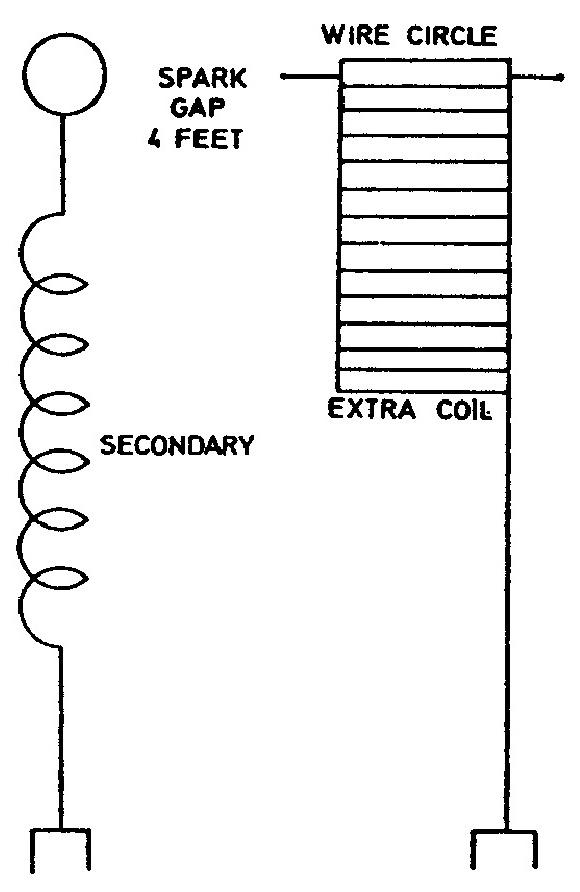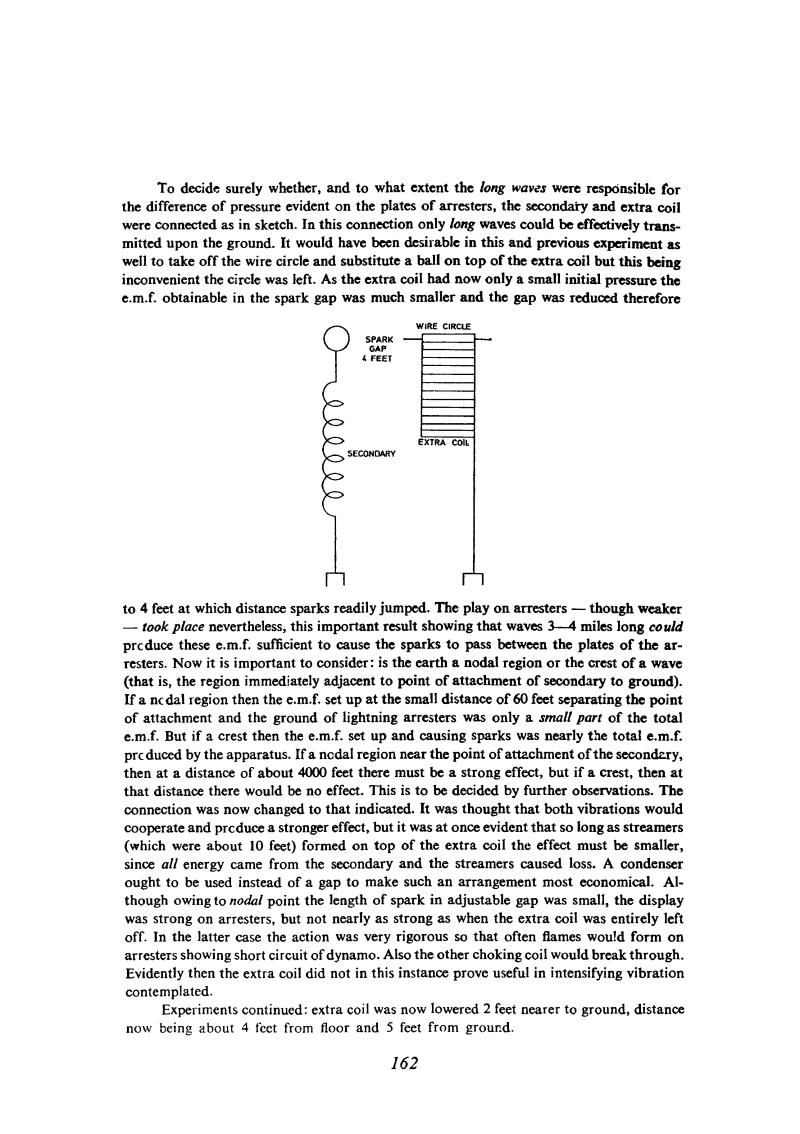
Nikola Tesla Books
To decide surely whether, and to what extent the long waves were responsible for the difference of pressure evident on the plates of arresters, the secondary and extra coil were connected as in sketch. In this connection only long waves could be effectively transmitted upon the ground. It would have been desirable in this and previous experiment as well to take off the wire circle and substitute a ball on top of the extra coil but this being inconvenient the circle was left. As the extra coil had now only a small initial pressure the e.m.f. obtainable in the spark gap was much smaller and the gap was reduced therefore
to 4 feet at which distance sparks readily jumped. The play on arresters - though weaker - took place nevertheless, this important result showing that waves 3 - 4 miles long could produce these e.m.f, sufficient to cause the sparks to pass between the plates of the arresters. Now it is important to consider: is the earth a nodal region or the crest of a wave (that is, the region immediately adjacent to point of attachment of secondary to ground). If a nodal region then the e.m.f. set up at the small distance of 60 feet separating the point of attachment and the ground of lightning arresters was only a small part of the total e.m.f. But if a crest then the e.m.f. set up and causing sparks was nearly the total e.m.f. produced by the apparatus. If a nodal region near the point of attachment of the secondary, then at a distance of about 4000 feet there must be a strong effect, but if a crest, then at that distance there would be no effect. This is to be decided by further observations. The connection was now changed to that indicated. It was thought that both vibrations would cooperate and produce a stronger effect, but it was at once evident that so long as streamers (which were about 10 feet) formed on top of the extra coil the effect must be smaller, since all energy came from the secondary and the streamers caused loss. A condenser ought to be used instead of a gap to make such an arrangement most economical. Although owing to nodal point the length of spark in adjustable gap was small, the display was strong on arresters, but not nearly as strong as when the extra coil was entirely left off. In the latter case the action was very rigorous so that often flames would form on arresters showing short circuit of dynamo. Also the other choking coil would break through. Evidently then the extra coil did not in this instance prove useful in intensifying vibration contemplated.
Experiments continued: extra coil was now lowered 2 feet nearer to ground, distance now being about 4 feet from floor and 5 feet from ground.
162
August 26
Tesla experimented with twice the interruption rate. The oscillator worked better and there was heavy sparking across the lightning arresters (Fig. 4). Investigating the cause of this sparking he inserted a coil in the lead of the metal sphere (Fig. 1) to reject high frequencies. In an earlier experiment (see July 30th) inserting such a choke coil in the ground line had stopped sparking across the arresters. This time it did not, so Tesla tried the circuit in Fig. 2. Still there was no marked change, the sparking across the arresters was only slightly reduced. After this experiment he began to wonder whether the grounding point of the secondary was not perhaps a peak rather than a node of the standing wave. It must be understood that Tesla thought that standing waves were set up around the transmitter (like waves on an open transmission line. With shorter waves the rate of change of amplitude with distance would be faster (i.e. maxima and minima would occur at shorter distance intervals), so he thought that a large potential difference could be obtained with a short distance between the grounding of the secondary and that of the lightning arrester.
In order to explain what happened when the sphere was not grounded (which would mean that there were no short waves) but the sparking across the arrester did not stop, Tesla found it necessary to formulate a new hypothesis: â Could the sparks be produced by static induction upon wire through the air and not chiefly by conduction through earth?â The experiment with which he tried to verify this hypothesis did not yield any definite answer.


